Background
Philips Lightolier is a vertically integrated reflector factory headquartered in Fall River, MA. The Fall River plant is about 310,000 square feet on a 31 acre property, and enjoys annual sales of approximately $155 million. This plant employs approximately 425 individuals and has implemented toxics use reduction methods since the late 1980s. More recently, Philips Lightolier has enacted specific measures to improve energy efficiency and conserve water throughout its facilities.
Energy Conservation
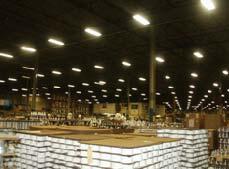
T5 high bays
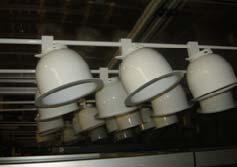
Powder-coated reflectors
Philips Lightolier has developed several new methods of reducing energy consumption in the Fall River plant. Some of the new strategies implemented include revamping its compressed air system and replacing factory lights with more energy efficient lighting. The company reduced natural gas consumption by 42 percent and saved $345,000 from 2007-2011, primarily by phasing out its rooftop heaters and implementing low temperature cleaners on its three cleaning lines. The company was able to eliminate these heaters by using the process heat generated by its new powder coating line to provide comfort heat for half the facility. Additionally, Philips Lightolier reduced electricity use by 40 percent via the lighting upgrades, compressor improvements, and the installation of variable frequency drives (VFDs).
“Implementing toxics use reduction and resource conservation has helped us to provide Green Products from Green Processes. We’ve made a lot of friends over the years at OTA and TURI and look forward to our continued relationship with them and many more successful projects in the coming years.”
Compressed Air Improvement
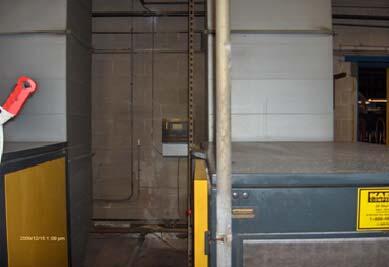
Compressed air system
Philips Lightolier installed several new measures to ensure that its compressed air system was operating as efficiently as possible. Before beginning the leak repairs at the facility, the company conducted pre-metering and leak surveys to establish baseline reports. Following the leak repair and baseline report, the company installed a permanent air management system that also came with a vertical receiver and dryer, to monitor any potential leaks. These projects cost a total of $14,200, and were entirely covered by National Grid rebates. The following table lists each project, the total cost and subsequent National Grid rebate, and reduced electricity use (in kWh) per year.
| Project | Project Cost | National Grid Rebate | Reduced kWh/Year | Annual Cost Savings |
|---|---|---|---|---|
| Leak repairs | ~$7,500 | $3,300 | 381,951 | $47,389 |
| 3,000 gallon vertical receiver, 520 cfm cycling dryer (including shipping) | ~$36,300 | $16,543 | 100,000 | $12,407 |
| Post-installation monitoring, distribution improvements | $5,000 | $2,250 | 50,000 | $6,204 |
| Total | $63,000 | $36,293 | 531,951 | $66,000 |
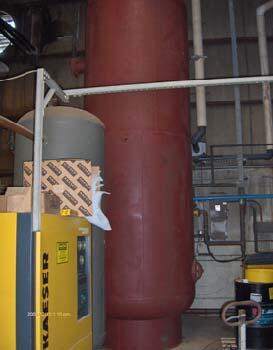
3,000 gallon vertical receiver
These improvements have reduced the company’s energy use by 531,951 kWh annually, which translates to $66,000 per year in financial savings. Most notably, the company has reduced its electricity use by nearly 400,000 kWh annually from repairing air leaks, saving approximately $47,000 in electricity use each year. Through incentives from National Grid, the company was able to minimize costs related to these energy efficiency projects. In total, the company paid $26,707 – a payback period of only 20 weeks.
Factory Relighting
As part of the factory relighting project, Philips Lightolier replaced 100w metal halide (MH) and T12s with high bay T5s and T8 task lights. The project took two phases to complete. The first phase included assembly and shipping of 242 T5 high bays, 16 T8 emergency fixtures, and 77 T8 task lights.
| Project | Project Cost | National Grid Rebate | Reduced kWh/Year | Annual Cost Savings |
|---|---|---|---|---|
| Phase 1: Assembly and shipping of 242 T5 high bays, 16 T8 emergency fixtures, and 77 T8 task lights | $83,000 | $43,000 | 323,000 | $40,233 |
| Phase 2: Fabrication, buffing, anodizing, and purchase of 291 T5 high bays, 17 T8 emergency fixtures, 83 T8 task lights | $95,772 | $85,968 | 247,000 | $30,767 |
| Total | $178,772 | $128,968 | 570,000 | $71,000 |
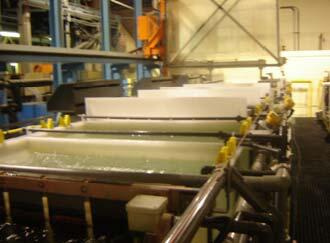
Typical process tanks in one of Philips Lightolier’s state-of-the-art automated anodizing lines
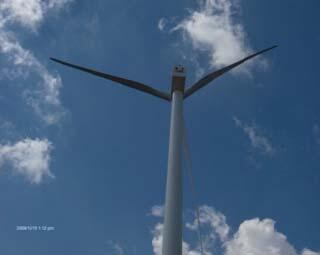
Wind turbine generator
Philips Lightolier reduced energy use by 570,000 kWh, and saved $71,000, annually from this project. Through incentives from National Grid, the company was able to minimize its costs to $49,804 – a payback period of 36 weeks.
Results
The compressed air and relighting projects reduced electricity use by 1,101,951 kWh, and saved the company $137,000 per year. In addition, Philips Lightolier recently installed a 2.0 MW wind turbine. The company plans to sell million kWh back to the grid, which will offset two-thirds of the company’s annual 6 million kWh usage. This is estimated to save Philips Lightolier $480,000 annually. Philips Lightolier has recently consolidated operations to maximize key competencies. During this time, the Fall River facility has maintained its profitability, largely due to the cost savings achieved through toxics use reduction and resource conservation efforts.
Download
Published 2012